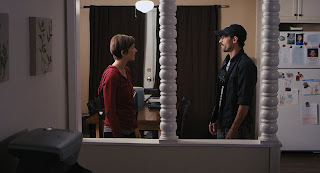Movie Review - Candyman (2021)
However, it's not just about avoiding making Black people villains or even victims. It's also about advancing narratives where Black people are at the center or are the significant focus. Yet, Black people are entitled to their own myths and legends, as well as to their own scary stories to tell around a veritable campfire, scary stories that aren't just the realities of their marginalized lives. Some might argue that Black people already have enough horror in their natural lives and that depicting that in cinema is akin to reveling in it. Some might argue that all that horror is ripe for storytelling in this genre. That's certainly been the tact of Jordan Peele, the Oscar-winning filmmaker of Get Out (2017) and who is the co-writer and producer of this film.
Yahya Abdul-Mateen II (The Trial of the Chicago 7 and Aquaman) stars as Anthony McCoy, an artist and painter who lives in Chicago. When the brother of his girlfriend tells him about the story of Candyman, he begins researching it. The story involves people saying the name "Candyman" in a mirror five times in order to summon the killer. Anthony says the name five times and even does an art exhibit where he encourages others to do the same. When they do, those people start getting murdered. There doesn't appear to be any rhyme or reason. Anthony starts investigating the murders when strange things start happening to him.Seemingly, Anthony becomes the prime suspect or the one who is framed for the murders. It's the same as with the 1992 film. In the 1992 film, the person who starts investigating Candyman is the one who becomes the prime suspect and the one the police frame for Candyman's murders. However, the 1992 film made it clear that the protagonist wasn't the killer but would eventually take on the identity or persona of the killer. With this film, it's not clear if Anthony is being framed or if he's actually the killer. There is a Quantum Leap (1989) moment where Anthony looks in the mirror and sees his reflection is that of the Candyman. There are moments here that also indicate that Anthony is transforming.
Yet, if that's the case, then there are other things that happen that contradict what the filmmakers here are trying to say. The original 1992 film was about urban legends and fear of the ghetto, as well as various other things like a woman's alienation and descent into madness. This film appears to be about various things, including gentrification and even Black Lives Matter. A little bit of that racial animus was present in the 1992 film. This film really underscores it, underscoring the history of lynching in the United States, which is supposed to fuel the motivation for the killings in this film.With the exception of the final sequence, the film doesn't really realize the thematic power that it appears to wield. The cohesive force in the original film was Candyman's need to have people believe in him and fear him. In that vein, his victims could be anybody, anybody in the city or world, but particularly the Black people in one community, as he appears to be a specter haunting that particular ghetto community. In that case, his victims were predominantly Black people. However, as white people spread the story, Candyman's victims expanded to white people. There didn't seem to be a preference in the 1992 film.
This film feels like it has a preference. This film's preference seems to be only killing white people. Given how this film underlines lynching of Black men, it almost props up Candyman as an avenging angel, targeting those in the race of those who committed those lynchings. That preference gets muddled when we see Candyman kill a Black person. There is a Black Lives Matter element to this film. In 2020, a slogan or rally cry for Black Lives Matter, especially in the revelation about Breonna Taylor's death, was "Say Her Name." This film appropriates that slogan and repeats "Say My Name." In order to summon Candyman, one has to say his name five times in a mirror. The BLM slogan is meant to reinforce the humanity and the lives lost. It's ironic then that this film would appropriate that slogan but to make it a tool for revenge.Unfortunately, this version, directed and co-written by Nia DaCosta, isn't as scary or terrifying as the 1992 version. For starters, Candyman isn't as active a presence in this film as he was in the 1992 version. In the 1992 version, Candyman, played by Tony Todd, actually had lines of dialogue, including whispered voice-overs that gave you chills worse than the blood and gore. He was also given this creepy religious aspect that was also very scary. A lot of his appearances were in the daytime and out in the open, which made him even scarier. Strangely, Todd was even a bit sexy in that original flick. DaCosta's version has him as a generic boogeyman that is barely seen and is mostly obscured.
Spoiler alert! Spoiler alert! Spoiler alert!
Colman Domingo (Ma Rainey's Black Bottom and If Beale Street Could Talk) plays William Burke, a former resident of Cabrini-Green, the Chicago ghetto from the 1992 film. He now runs a laundromat. He realizes the history of lynching that links the ghetto with the Candyman legend. As a little boy, William encountered a man who looked like the Candyman but was turned into the Candyman when he was lynched by police. William then feels compelled to turn Anthony into the Candyman, but, Anthony is also seemingly being transformed into the Candyman by himself, so I don't get what William's point was.Rated R for bloody violence, language and some sexual references.
Running Time: 1 hr. and 31 mins.
In theaters.















Comments
Post a Comment